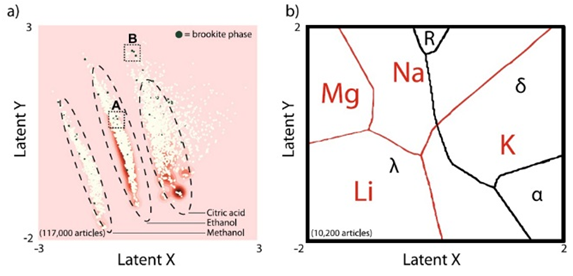 Virtual screening of inorganic materials synthesis parameters with deep learning (无机材料合成参数的深度学习-虚拟筛选法)
Virtual screening of inorganic materials synthesis parameters with deep learning (无机材料合成参数的深度学习-虚拟筛选法)
Edward Kim,Kevin Huang,Stefanie Jegelka&Elsa Olivetti
Computational methods; Design,synthesis and processing; Materials science
npj Computational Materials 3:53 (2017)
doi:10.1038/s41524-017-0055-6
Published online:16 October 2017
Abstract| Full Text | PDF OPEN
摘要:近十年来,由于第一原理计算技术和机器学习算法两方面快速发展的推动,材料虚拟筛选方法种类激增。相比之下,计算驱动的材料合成筛选仍处于起步阶段,深陷数据稀疏性和数据稀缺性的困境:合成工艺存在于难以直接优化的稀疏、高维参数的空间,此外,一些引人注目的材料,其合成却鲜有文献报道。本研究提出了一个框架来量化合成参数和潜在驱动因素与合成产物之间的关系。我们发现,采用变分自编码器将稀疏合成表达方式压缩到较低维空间,可以提高机器学习的工作能力。为使这个筛选框架在文献数据很少的情况也能有效,本研究设计了一种新的数据增强方法,从相关材料系统合成的文献数据中提取需要的信息。采用这种变分自编码器框架来生成潜在的SrTiO3合成参数集,本研究提出了板钛矿TiO2形成的多个驱动因素,并确定了碱性离子嵌入和MnO2多晶型物选择之间的相关性。
Abstract:Virtual materials screening approaches have proliferated in the past decade, driven by rapid advances in first-principles computational techniques, and machine-learning algorithms. By comparison, computationally driven materials synthesis screening is still in its infancy, and is mired by the challenges of data sparsity and data scarcity: Synthesis routes exist in a sparse, high-dimensional parameter space that is difficult to optimize over directly, and, for some materials of interest, only scarce volumes of literature-reported syntheses are available. In this article, we present a framework for suggesting quantitative synthesis parameters and potential driving factors for synthesis outcomes. We use a variational autoencoder to compress sparse synthesis representations into a lower dimensional space, which is found to improve the performance of machine-learning tasks. To realize this screening framework even in cases where there are few literature data, we devise a novel data augmentation methodology that incorporates literature synthesis data from related materials systems. We apply this variational autoencoder framework to generate potential SrTiO3 synthesis parameter sets, propose driving factors for brookite TiO2 formation, and identify correlations between alkali-ion intercalation and MnO2 polymorph selection.
Editorial Summary
Machine learning: Computer-generated recipes for materials synthesis (机器学习:由计算机给出的材料合成配方)
该研究揭示,合成无机材料的配方现在可由机器学习给出。来自麻省理工学院的Elsa Olivetti教授等开发了一种算法,能够为实验合成一些化合物而“学习”,从而给出新的合成方法步骤。合成过程的“虚拟筛选”将成为合成化学家有用的辅助工具,但由于材料合成通常很复杂,阻碍了这一领域的发展,使其仍处于起步阶段。该研究采用合成的一些代表性关键参数(如反应温度)来简化问题的复杂性,训练相关的算法。作为原理的一个例证,Elsa Olivetti用该法生成了钛酸锶的合成参数,并揭示了其他无机氧化物合成的独到方法。作者希望他们的方法,最终可以作为预测无机材料合成的一种“虚拟筛选”方法。
Recipes for synthesizing inorganic materials can now be generated by machine learning. Elsa Olivetti and coworkers at the Massachusetts Institute of Technology have developed an algorithm capable of ‘learning’ new procedures for synthesizing compounds in the lab. ‘Virtual screening’ for synthetic procedures would be a useful tool to aid synthetic chemists, however the field is still nascent with progress hindered by the often complex nature of materials synthesis.Here, the authors simplified the problem by representing syntheses by some key parameters (e.g. reaction temperature), which were used to train the algorithm.As a proof-of-principle, Olivetti used the method to generate synthesis parameters for strontium titanate, as well as revealing insights into the formation of other inorganic oxides. The authors hope their method may eventually lead to a predictive ‘virtual screening’ approach to inorganic materials synthesis.


 沪公网安备 31010502006565号
沪公网安备 31010502006565号